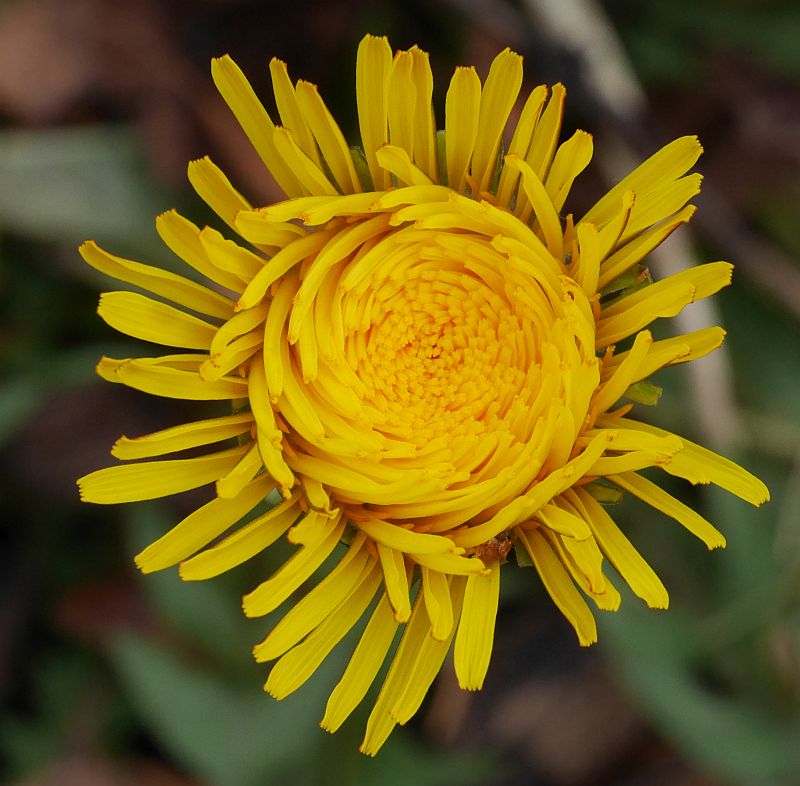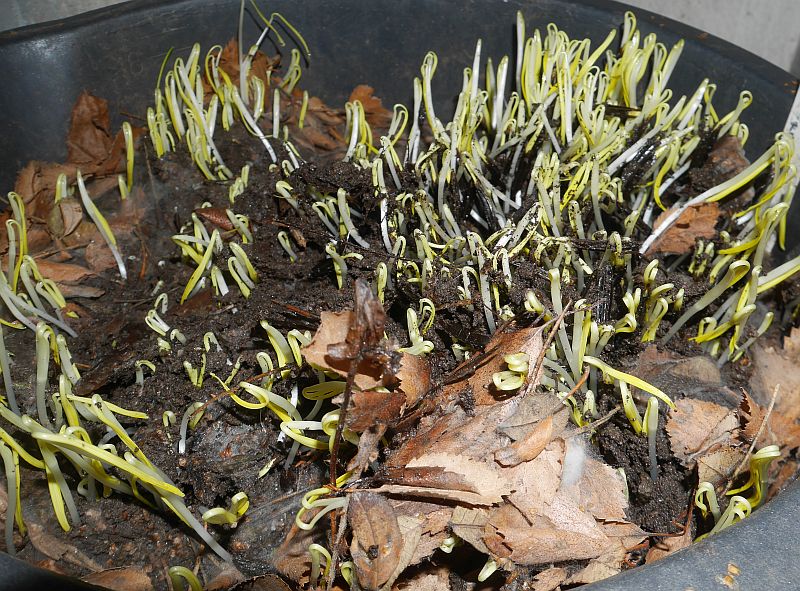Probably the last dandelion to flower in the edible garden in 2020! The temperature didn’t drop below +12C last night, but there may be snow later in the week!


I was working at Væres Venner Community Garden yesterday and noticed a deformed (fasciated) dandelion flower. This can be caused by a range of factors including random genetic mutation, virus and bacterial infections. Damage to the plant’s growing tip and exposure to cold and frost can also cause fasciation and with the very cold weather after a mild start to spring is probably the cause in this case (see https://en.wikipedia.org/wiki/Fasciation).
Searching around I discovered two other fasciated dandelions! This phenomenon is rare, but I have seen it before a few times. However, I’ve never seen more than one plant affected within a small area before! I photographed each of the plants below and fantasising about making fascinating fasciated dandinoodles* or rather dandi-lasagne as the flower stems are flattened :)
Unfortunately, this mutation doesn’t seem to return in the following year in dandelions..
*Dandinoodles (løvenudler) are made from quickly boiling the flower stems perferably before the flowers open and just mixing with butter or olive oil:
Fasciated Plant #1 had twin or siamese flowers:
Fasciated Plant #2 had 6 flowers on the one stem and a twisted flower stem! Note that the fasciated stem is shorter than the normal flower stems:
Fasciated Plant #3 was different again, this time a single distorted flower (cresting):
My Taraxacum albidum is looking good at the moment!
The seed for this came from the Scottish Rock Gardening Club seed list 2016/17 (SRGC3660) and I planted two plants here. However, they look different in that the leaf shape is different (T. albidum is described as having deeply indented leaves) and only one has hairy scapes (as T. albidum). I suspect some crossing has been going on.
T albidum is itself a hybrid between white flowered Taraxacum coreanum and Taraxacum japonicum.
To celebrate my 65th we made indian pakora with 65 (or so) different perennial vegetables. Going for a new title, this time EPM (Extreme Pakora Man)! Any better? The whole list is under the pictures!
Just wish I’d had broad / fava bean (bondebønner) flour available for the pakoras rather than gram flour (chick peas)…next time I hope :)
Begonia heracleifolia var nigricans (leaf petiole)
Cilantro / Bladkoriander
Dill
Oxalis triangularis (two varieties)
Gynostemma pentaphyllum (sweet tea vine)
Crithmum maritimum (rock samphire / sanktpeterskjerm)
Parsley / persille
Garlic / Hvitløk “Valdres”
Garlic / Hvitløk “Lochiel”
Garlic / Hvitløk (sprouts)
Chenopodium ambrosioides (epazote / sitronmelde)
Chrysanthemum coronarium “Chopsuey Greens”
Perennial kale / flerærige kål “Heligoland”
Perennial kale / flerærige kål “Daubenton Variegated”
Urtica dioica (nettle / nesle)
Hablitzia tamnoides (Caucasian spinach / stjernemelde)
Allium ursinum (ramsons / ramsløk)
Hydrophyllum virginianum (Virginia waterleaf, Indian salad)
Primula elatior (oxlip / hagenøkleblom)
Primula “Sunset shades”
Rhubarb / rabarbra “Victoria”
Rhubarb / rabarbra “Træna”
Allium fistulosum (Welsh onion / pipeløk)
Allium cernuum (Chicago onion, nodding onion / prærieløk)
Myrrhis odorata (sweet cicely / Spansk kjørvel)
Sium sisarum (skirret / sukkerrot)
Heracleum sphondylium (common hogweed / kystbjørnekjeks)
Allium scorodoprasum (sand leek / bendelløk, skogløk)
Taraxacum officinale (dandelion / løvetann) (leaves, roots and flowers)
Matteuccia struthiopteris (ostrich fern / strutseving)
Houttuynia cordata “Chinese Market”
Allium carolinianum
Allium schoenoprasum (chives / gressløk)
Rheum palmatum var tanguticum (Turkey rhubarb/ prydrabarbra)
Bistorta officinalis (bistort / ormerot)
Allium x proliferum (walking onion / luftløk) “Amish Topset”
Campanula latifolia (giant bellflower / storklokke)
Aegopodium podograria (ground elder / skvallerkål)
Carum carvi (caraway / karve) (leaves)
Aralia cordata (udo) (short blanched shoot)
Crambe maritima (sea kale / strandkål)
Allium douglasii (Douglas’ onion / Douglas-løk)
Allium nutans (Siberian nodding onion / sibirsk nikkeløk)
Hemerocallis spp. (day lily / daglilje)
Allium victorialis (victory onion / seiersløk) “Lofoten”
Rumex acetosa (sorrel / engsyre)
Levisticum officinale (lovage / løpstikke) (blanched)
Smilacina racemosa ( false spikenard / toppkonvall) “Emily Moody” (blanched)
Hosta “Frances Williams”
Tragopogon pratensis (Jack-go-to-bed-by-noon / geitskjegg)
Barbarea vulgaris ssp arcuata (winter yellowcress / vinterkarse)
Barbarea vulgaris ssp vulgaris (winter yellowcress / vinterkarse)
Allium paradoxum var normale (few-flowered leek)
Angelica archangelica ssp archangelica v. Majorum (Angelica / kvann) “Vossakvann”
Dystaenia takesimana (Ulleung giant celery)
Alliaria petiolata (garlic mustard / løkurt)
Rudbeckia lacinata (Cherokee greens)
Armoracia rusticana (horseradish / pepperrot) (blanched greens)
Rumex patientia (patience dock / hagesyre)
Allium pskemense
Taraxacum sublaciniosum “Delikatess” (dandelion / løvetann) “Moss-leaved dandelion”
Taraxacum albidum
Phyteuma nigra (black rampion / svartvadderot) (greens)
(Golpar was in the pakora batter along with chili, ajwain and black onion seed, Nigella)
It’s 100 years since Vilmorin-Andrieux’s The Vegetable Garden: Illustrations, descriptions, and culture of the garden vegetables of cold and temperate climates was published! The plant I most associate with this fantastic book is what I’ve called “The Legendary Moss-Leaved Dandelion”. I fell in love with the image of this variety of dandelion when I first saw it (see below) and I later blogged about how I sought after and was finally able to grow it myself here: https://www.edimentals.com/blog/?page_id=1193
There was even a T-shirt printed in its honour (see https://www.edimentals.com/blog/?page_id=1043)
However, it was only yesterday that I discovered how mossy looking it can be in the early spring when I tried to clean moss away from the young dark leaves of a plant I was harvesting for a salad ;)
A much warmer winter than normal and I returned home to well developed blanched dandelion shoots in the cellar together with horseradish shoots and the sweet cicely shoots (Myrrhis odorata) had also germinated en masse!
This post shows the dandelion roots being dug and planted at the end of November: http://www.edimentals.com/blog/?p=23997




At last, it’s a reality!! Since I heard that Continental were testing the world’s first car tyre with Taraxagum two years ago, I’ve included a picture of the tyre in my talks! I typically tell how dandelions are one of the most important plants on the planet and that you can make a multi-course dinner of different products of the plant (see my book for details) from root crop, salad, dandinoodles to dandichokes, dandelion wine, coffee, tea etc. etc. and I end up by saying that soon you’ll even be able to cycle home on tyres made of dandelion rubber!! I’ll use this picture from now on!!
In the link, it’s mentioned that Germany’s Fraunhofer Institute and University of Münster have helped Continental with the development of the tyre. I was approached by researchers at the university offering me EUR40 for my dandelion seed (that they’d found offered on my Garden Web Internet seed trade list) and, later, asking me to produce as much seed as possible of the rubber dandelion Taraxacum kok-saghyz (more of this story, which has a twist at the end, is told in my book).
The email offering me cash for dandelions can be read here:
(20th April 2005 from a scientist at the University of Münster). I’d asked for other species of dandelion in return as a trade.
“Thanks Stephe for your early reply.
Sorry, we are just at the beginning of our work and therefore we could offer you just some seeds of Taraxacum officinale, but non of the others.
So, what should be the price for the seeds and the postage, around 40€?
list of seeds:
Taraxacum faeroense (02) ;
Taraxacum kok-saghyz (03; 02; 01)6;Rubber Dandelion Taraxacum mongolicum (03; 01 ); Taraxacum officinale (02; 00 ) ;Pissenlit (French cultivated Dandelion) OUT Taraxacum pamiricum (03); Taraxacum sect. erythrosperma (03; 02) ; Taraxacum vulgare album (02) ;
Please let me know to which address we should send the money. Please send the seeds in a safe envelope and it would be nice to have them as early as possible. You can be sure that you will get the money!”